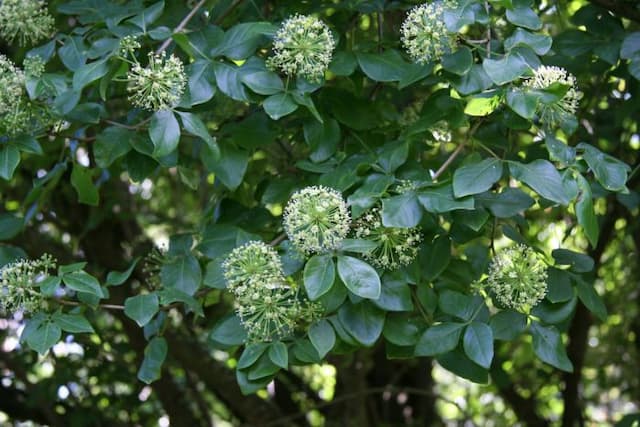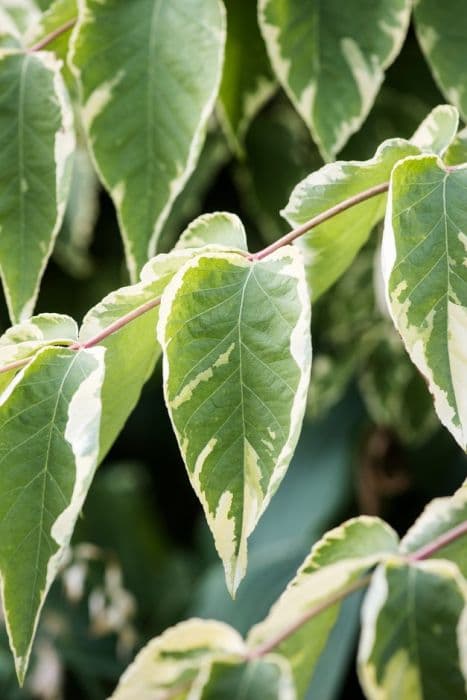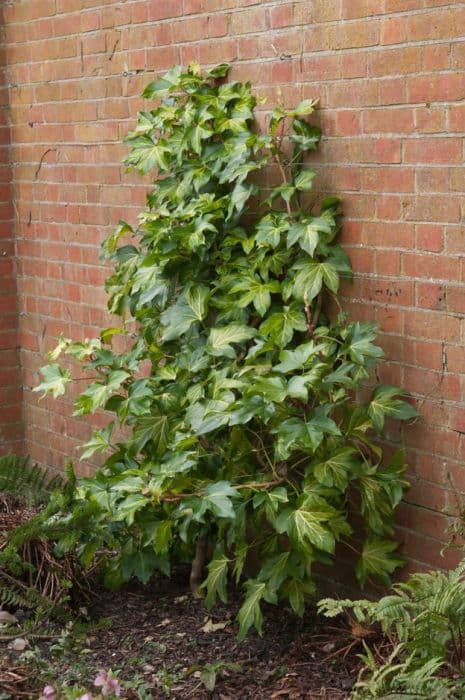English Ivy Hedera helix 'Caecilia' (v)

ABOUT
The Hedera helix 'Caecilia' is commonly known as English ivy. This variety of English ivy is distinct for its ornamental foliage which creates an appealing visual interest. Its leaves are variegated, featuring a mix of green hues and creamy-white to yellow edges, presenting a striking contrast. The leaves are typically shaped with three to five lobes, with the central lobe often being the longest, giving the foliage an attractive, somewhat star-like shape. The leaf texture is smooth with prominent veins that give the leaf surface a slightly quilted appearance. This variety, being a type of ivy, is a climbing plant known for its ability to latch onto surfaces with its aerial rootlets. These rootlets allow the plant to adhere to different structures and climb vertically or spread horizontally, depending on the support provided. When grown without support, it can also serve as a trailing or ground-cover plant, with stems that grow along the ground. Like other ivies, 'Caecilia' can adapt to a variety of light conditions, from shady spots to areas with more sunlight. Its variegated foliage may become more pronounced with increased light exposure. However, colors may also fade if the light is too intense. This plant can also produce small, inconspicuous flowers and berries in its mature state, but it is primarily cultivated for its beautiful and lush foliage. The English ivy 'Caecilia' is an evergreen plant, providing year-round visual interest. It is also a favored choice for indoor growing, used to decorate spaces with its cascading vines, or outdoors as a decorative cover that enhances the aesthetic of walls, fences, and garden features.
About this plant
 Names
NamesFamily
Araliaceae.
Synonyms
English Ivy, European Ivy, Common Ivy.
Common names
Hedera helix 'Caecilia'
 Toxicity
ToxicityTo humans
English Ivy, including the Hedera helix 'Caecilia' variant, is toxic to humans if ingested. The plant contains saponins, which can cause poisoning. Symptoms of poisoning include abdominal pain, vomiting, and diarrhea. In some cases, it can also cause excessive salivation, fever, and a burning sensation in the throat. Ingesting large amounts of the plant can lead to more severe reactions such as delirium or convulsions. Skin contact with the sap may result in dermatitis in sensitive individuals.
To pets
English Ivy is also toxic to pets, including dogs and cats. The Hedera helix 'Caecilia' contains compounds such as saponins that can cause vomiting, abdominal pain, hypersalivation, and diarrhea if ingested by pets. In some cases, pets may experience difficulty breathing, increased heart rate, or muscle weakness. Consumption of large quantities can cause severe gastrointestinal distress, ataxia, and potentially can be fatal if not treated promptly.
 Characteristics
CharacteristicsLife cycle
Perennials
Foliage type
Evergreen
Color of leaves
Variegated
Height
6-9 feet (1.8-2.7 meters)
Spread
3-4 feet (0.9-1.2 meters)
Plant type
Climber
Hardiness zones
5
Native area
Europe
Benefits
 General Benefits
General Benefits- Enhances visual interest: Hedera helix 'Caecilia', commonly known as English ivy, adds an aesthetic appeal to gardens and indoor spaces with its variegated foliage.
- Adaptable to various environments: It can thrive in a range of conditions, from full shade to full sun, making it a versatile plant for different garden locations.
- Easy to care for: English ivy requires minimal maintenance, is resilient to neglect, and can survive with occasional watering and feeding.
- Provides year-round greenery: This evergreen vine retains its leaves throughout the seasons, contributing a constant splash of green to the landscape.
- Ideal for ground coverage: It spreads effectively over the ground, which can help control erosion and suppress weeds.
- Vertical accent: English ivy can climb walls and trellises, offering a vertical dimension to gardens and creating natural "green" walls.
- Creates wildlife habitats: The dense foliage provides shelter and breeding spaces for birds and insects within the garden ecosystem.
 Medical Properties
Medical Properties- Expectorant: English Ivy (Hedera helix) leaves have been used to help relieve cough and congestion.
- Antispasmodic: The saponins in the plant may help in relieving bronchial spasms.
- Topical treatment for skin conditions: It has been used in traditional medicine as a topical treatment for certain skin conditions, such as minor burns and wounds.
 Air-purifying Qualities
Air-purifying QualitiesThis plant is not specifically known for air purifying qualities.
 Other Uses
Other Uses- Hedera helix 'Caecilia', commonly known as English Ivy, can be used in topiary art to create living sculptures, as it can be trained to grow over frames and take on various shapes.
- The vine's ability to cling to surfaces can be utilized in soundproofing efforts, where its dense growth helps to dampen noise when grown against walls.
- In photography and film, English Ivy is often used as a backdrop to give scenes a lush, green appearance or to create a mood of antiquity and romance.
- Used in landscape design to cover unattractive features like old stumps or unsightly fences, English Ivy can disguise these elements by enveloping them in greenery.
- English Ivy can be woven into wreaths or used as a base for floral arrangements, providing a natural and ornate look for event decorations.
- Educational projects, such as teaching about plant growth or the life cycle of a vine, can incorporate English Ivy due to its hardiness and ease of observation.
- English Ivy is sometimes used to create natural dyes for fabrics, yielding a range of green hues depending on the mordant used.
- Its dense foliage provides shelter and nesting material for birds within urban environments where natural habitats may be limited.
- Creative arts and crafts projects can use English Ivy leaves for making prints, stamps, or included in paper-making for adding texture and visual interest.
- In culinary arts, though not commonly consumed due to its potential toxicity, the aesthetic appeal of English Ivy leaves is sometimes used to enhance the presentation of gourmet dishes after ensuring the leaves are safe and non-toxic to touch food items.
Interesting Facts
 Feng Shui
Feng ShuiThe English Ivy is used in Feng Shui to bring balance and positive energy to a home. It is believed to purify the air and remove toxins, promoting physical and emotional health. Its evergreen nature symbolizes vitality and perseverance. In Feng Shui, it can be placed in the wealth area to promote prosperity or in the family area to encourage growth and harmony.
 Zodiac Sign Compitability
Zodiac Sign CompitabilityThe English Ivy is not used in astrology practice.
 Plant Symbolism
Plant Symbolism- Fidelity: English Ivy is often associated with faithfulness and enduring love, signifying strong attachments and lifelong bonds. It clings to surfaces, symbolizing the clinging nature of love.
- Eternal Life: Due to its evergreen nature, English Ivy symbolizes immortality and eternal life, reflecting the human longing for life beyond the temporal.
- Friendship: The ivy's interwoven growth habits represent the interconnectedness of friends and the way relationships grow in an intertwined manner.
- Protection: Historically, ivy has been used in wreaths and decorations to ward off evil spirits, symbolizing protection and safekeeping.
- Prosperity: The vigorous growth and greenness of English Ivy convey abundance and the idea of thriving in various conditions, suggesting prosperity.
 Water
WaterEnglish Ivy prefers consistent moisture, but it's important not to let it sit in waterlogged soil. Water the plant when the top inch of soil feels dry to the touch, which typically means watering once every 7 to 10 days. When watering, make sure to apply water evenly, soaking the soil to a depth of at least one inch, which might roughly correspond to 16 to 32 ounces of water for a standard indoor pot. Reduce watering during the winter months when the plant is not in active growth. Always empty the saucer beneath the pot after watering to prevent root rot.
 Light
LightEnglish Ivy thrives in bright, indirect light but can also adapt to low light conditions. The best spot for your Ivy is near a window that receives filtered sunlight, perhaps through a sheer curtain. Direct afternoon sun can be intense and may scorch the leaves, so it's better to provide some protection during these hours. If the Ivy doesn't receive sufficient light, you may notice leggy growth as the plant stretches towards the nearest light source.
 Temperature
TemperatureEnglish Ivy does best in temperatures between 50°F and 70°F. It can survive minimum temperatures of down to around 30°F, but freezing temperatures can damage the plant. The plant prefers a consistent temperature range and may struggle with drastic temperature fluctuations. Protect it from drafts and extreme heat sources to maintain an ideal growing environment.
 Pruning
PruningEnglish Ivy benefits from pruning to encourage bushier growth, remove dead or damaged foliage, and maintain its desired shape. Prune the plant whenever it appears overgrown, typically in the spring or summer when the plant is in active growth. It's best to use sharp scissors or pruning shears to make clean cuts, which will minimize stress on the plant. Regular trimming can also rejuvenate older ivies that have become leggy.
 Cleaning
CleaningAs needed
 Soil
SoilEnglish Ivy 'Caecilia' thrives in a well-draining soil mix composed of peat, perlite, and organic matter, with a pH range of 5.5 to 6.5 for optimal growth.
 Repotting
RepottingEnglish Ivy 'Caecilia' should be repotted every two years to encourage healthy growth and prevent it from becoming root-bound in its container.
 Humidity & Misting
Humidity & MistingEnglish Ivy 'Caecilia' prefers a moderate to high humidity level, ideally between 40% and 70%, to maintain its lush foliage.
 Suitable locations
Suitable locationsIndoor
Place English Ivy 'Caecilia' in bright, indirect light and keep soil consistently moist.
Outdoor
Plant in partial shade to full shade and keep soil well-drained.
Hardiness zone
5-11 USDA
 Life cycle
Life cycleThe life of English Ivy 'Caecilia' (variegated) begins with seed germination, which can take place in a variety of conditions but is most successful in moist, rich soil. Once the seed germinates, a juvenile plant emerges, which has lobed leaves and a trailing or climbing growth habit, allowing it to attach to surfaces with aerial rootlets. As it matures, the plant enters a vegetative stage characterized by rapid growth and expansion; its variegated leaves are particularly attractive during this time. Following the vegetative stage, English Ivy may take several years to reach reproductive maturity, at which point it develops adult, non-lobed leaves and eventually produces small, inconspicuous flowers in the late summer or early fall. After pollination, the flowers give way to small, blue-black berries that are dispersed primarily by birds. The final stage in the plant's life is senescence, where growth slows, and the plant may die back, though English Ivy is often persistent and can live for many years.
 Propogation
PropogationPropogation time
Spring-Early Summer
The English Ivy 'Caecilia', as with most cultivars of Hedera helix, is typically propagated through stem cuttings. This method is the most popular due to its high success rate and ease of execution. The ideal time to take stem cuttings is during the spring or early summer when the plant is actively growing. To propagate English Ivy 'Caecilia', one should select a healthy stem with several leaves and cut a 4 to 6 inch (10 to 15 centimeters) section, making sure to cut just below a leaf node. This node is where the new roots will sprout from. After removing the lower leaves to expose the node, the stem cutting can be placed in water or directly into soil. If rooting in water, change the water every few days to prevent bacterial growth. Once roots that are at least an inch (2.5 centimeters) long have developed, the new ivy plant can be transferred to a pot with soil to continue growing.









